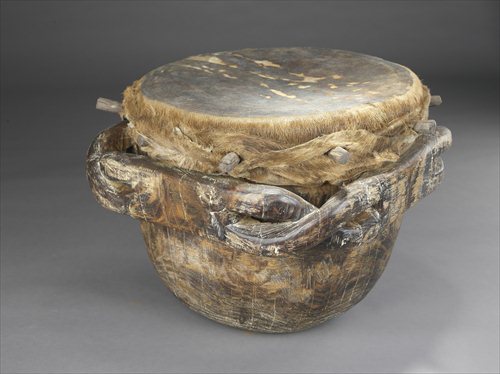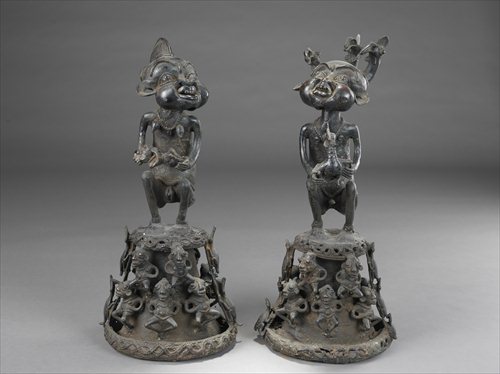Out of Africa
Exhibition brings sculptures from across the African continent to Shanghai
In the past year Shanghai has seen many exhibitions of Western masters such as Picasso, Dalí and Miró. While this has allowed gallery-goers in the city to become more familiar with these artists, few may realize that they all, to some extent, found inspiration in African art.
In 1906, the young Picasso was inspired by African masks and started his African-influenced period (1907-09). This led directly into his Cubist period.
But for many people in China and the West, African art is little known. Recently, the One Family One Way Exhibition of African Sculpture 2015 opened in Shanghai with the aim of introducing African sculpture, a signature arm of African arts.
The exhibits include over 200 items, featuring masterpieces from African museum collections, presenting the audience with the essence of African art as well as some hints of Chinese cultural elements.
All the items were provided by Zhao Baopei, a collector who has lived in South Africa for 25 years and traveled among different African tribes to collect many art pieces.
Now retired, Zhao wanted to bring his collection to his home city of Shanghai and open it up to his countrymen.
"Although the commercial and trade connections between China and Africa are flourishing, many people still like to use the word 'mysterious' when they talk about Africa. It was the lack of cultural exchange between the two sides that caused Chinese people's unfamiliarity with the history and lives of African people," Zhao writes in the curatorial material.

Museum collection
The exhibits in the museum collection are provided by major museums from different African countries and have been displayed in a previous European tour.
Many of the contributing museums have written background introductions to accompany their pieces, giving viewers an in-depth understanding of their history and context.
Among the exhibits is a scepter (pictured above) that was presented to late South African president Nelson Mandela by Mutwa, one of the most distinguished Zulu fortune tellers and healers (known as Sangomas).
Another national treasure is a South African Zulu drum (below). They are traditionally used in ceremonies and a dance derived from war dances of warriors.
It is danced by men wearing animal skin, head rings, ceremonial belts, ankle rattles, shields and weapons like spears.

There are only four original versions of the drum, made by artist Mtambo Mashangou in 1942, on show in the world.
They are at the Metropolitan Museum of Art in New York, the Royal Museums Greenwich in London, the Museum Africa in South Africa, and this exhibition.

Exhibits on display at One Family One Way Exhibition of African Sculpture 2015 in Shanghai Photos: Courtesy of Zhao Baopei
Chinese cultural elements
Famed Ming Dynasty (1368-1644) admiral Zheng He led seven expeditionary voyages to the Indian Ocean from 1405 to 1433.
During the trip, he visited many African kingdoms and the influences he brought to Africa can be seen in some of the sculptures on display.
The sculpture Baule Deaf, Dumb, Blind that features three men - one blind, one deaf and one dumb - is reminiscent of the "see no evil, hear no evil, speak no evil, do no evil" tenet of Confucius that is often expressed in Chinese sculptures.
Figures in Chinese legends such as the God of Doors and God of Land can also be found in African sculptures.
There are two statues (above) placed at the entrance of a palace to prevent bad people with bad intentions from entering and harming the king. They serve the same function as the Chinese God of Doors.
Meanwhile, the Songwe statue is similar to the Chinese God of Land. The statues can be found in village temples.
If they fall down and land on their right side, it means good news for the village. However, if a statue falls and lands on its left side, it is seen as a bad omen.
Rising valuation
Nowadays people are starting to realize the value of African artworks. In an auction held by Sotheby's in November, 2014, a wood head sculpture from Gabon fetched $3.64 million.
Zhao believes much more effort needs to be put into preserving African sculptures.
"Over a decade ago when I started purchasing wood sculptures, the governments were not strong enough to protect them because of wars. Now the countries are stable and have started to build national museums. Nigeria is the first African country to pass a law that any cultural relics have to be stamped before they are exported. They are just beginning to realize the importance of cultural relic protection," Zhao told the Global Times.
Zhao is currently writing a book about African sculpture, which he said will be the first book of its kind in Chinese. When he finishes the book he will give it to schools, cultural institutions and museums for free.
Date: Until January 3, 9 am to 5 pm
(closed Mondays)
Venue: Shanghai Urban Planning Exhibition Center
Address: 100 People's Avenue
人民大道100号
Admission: 30 yuan ($4.63)
Call 6372-2077 for details